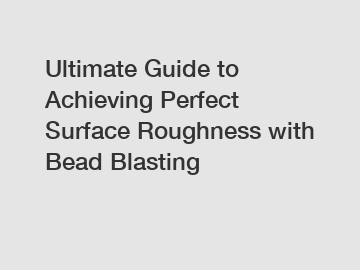Ultimate Guide to Achieving Perfect Surface Roughness with Bead Blasting
Apr. 05, 2024
Achieving perfect surface roughness is crucial in various industries, from aerospace to automotive to medical device manufacturing. One method that is widely used for achieving the desired surface finish is bead blasting. Bead blasting, also known as abrasive blasting, is a process where fine glass beads are propelled at high speed onto a metal surface to remove any impurities, smooth out rough surfaces, and achieve the desired surface roughness.
In this ultimate guide, we will discuss the key factors that influence the surface roughness achieved with bead blasting and provide you with tips on how to achieve perfect surface roughness every time.
1. Material Selection.

The type of material being blasted plays a significant role in determining the surface roughness achieved. Different materials have different hardness levels and require different blasting parameters to achieve the desired result. For example, softer materials such as aluminum may require lower blasting pressure and longer blasting times compared to harder materials like steel. It is crucial to understand the properties of the material being blasted and adjust the blasting parameters accordingly.
2. Blasting Media.
The blasting media used in bead blasting also plays a crucial role in determining the surface roughness achieved. Glass beads are the most common blasting media used for achieving a smooth and uniform surface finish. The size and shape of the beads, as well as the blasting pressure, impact the surface roughness achieved. Finer beads create a smoother surface finish, while larger beads create a more textured finish. It is essential to select the right blasting media based on the desired surface roughness and the material being blasted.
3. Blasting Parameters.
The blasting parameters, including blasting pressure, blasting distance, and blasting time, are crucial in achieving the desired surface roughness. Higher blasting pressure and shorter blasting distance can result in a rougher surface finish, while lower blasting pressure and longer blasting distance can achieve a smoother finish. It is important to experiment with different blasting parameters to find the optimal settings for achieving the perfect surface roughness.
4. Surface Preparation.
Proper surface preparation is key to achieving perfect surface roughness with bead blasting. The surface must be free of any contaminants, including oil, dirt, and rust, before blasting. Cleaning the surface thoroughly and ensuring it is dry will result in a more uniform and consistent surface finish. Additionally, masking off any areas that do not require blasting can help ensure that only the desired areas are impacted, leading to a more precise finish.
5. Blasting Technique.
The technique used during bead blasting also influences the surface roughness achieved. It is essential to maintain a consistent blasting pattern and movement to ensure an even finish. Overlapping each pass slightly can help prevent streaks and ensure uniform coverage. Additionally, adjusting the blasting angle and distance from the surface can help achieve the desired surface roughness. Practice and experience are key in mastering the blasting technique and achieving perfect surface roughness.
6. Post-Blasting Treatment.
After bead blasting, it is important to properly clean and treat the surface to maintain the desired surface roughness. Removing any residual blasting media and contaminants from the surface is crucial to prevent corrosion and ensure the longevity of the finish. Depending on the material being blasted, additional treatments such as passivation or coating may be necessary to protect the surface and maintain the desired roughness.
In conclusion, achieving perfect surface roughness with bead blasting requires attention to detail, experimentation, and experience. By understanding the key factors that influence surface roughness, selecting the right blasting media, adjusting blasting parameters, preparing the surface properly, mastering the blasting technique, and performing post-blasting treatment, you can achieve the desired finish every time. With practice and dedication, you can become a master of bead blasting and achieve perfect surface roughness in your projects.
Contact us to discuss your requirements of mirrored stainless steel panels, lift cabin roof, stamped sheet metal panels free sample. Our experienced sales team can help you identify the options that best suit your needs.
106
0
0


Comments
All Comments (0)